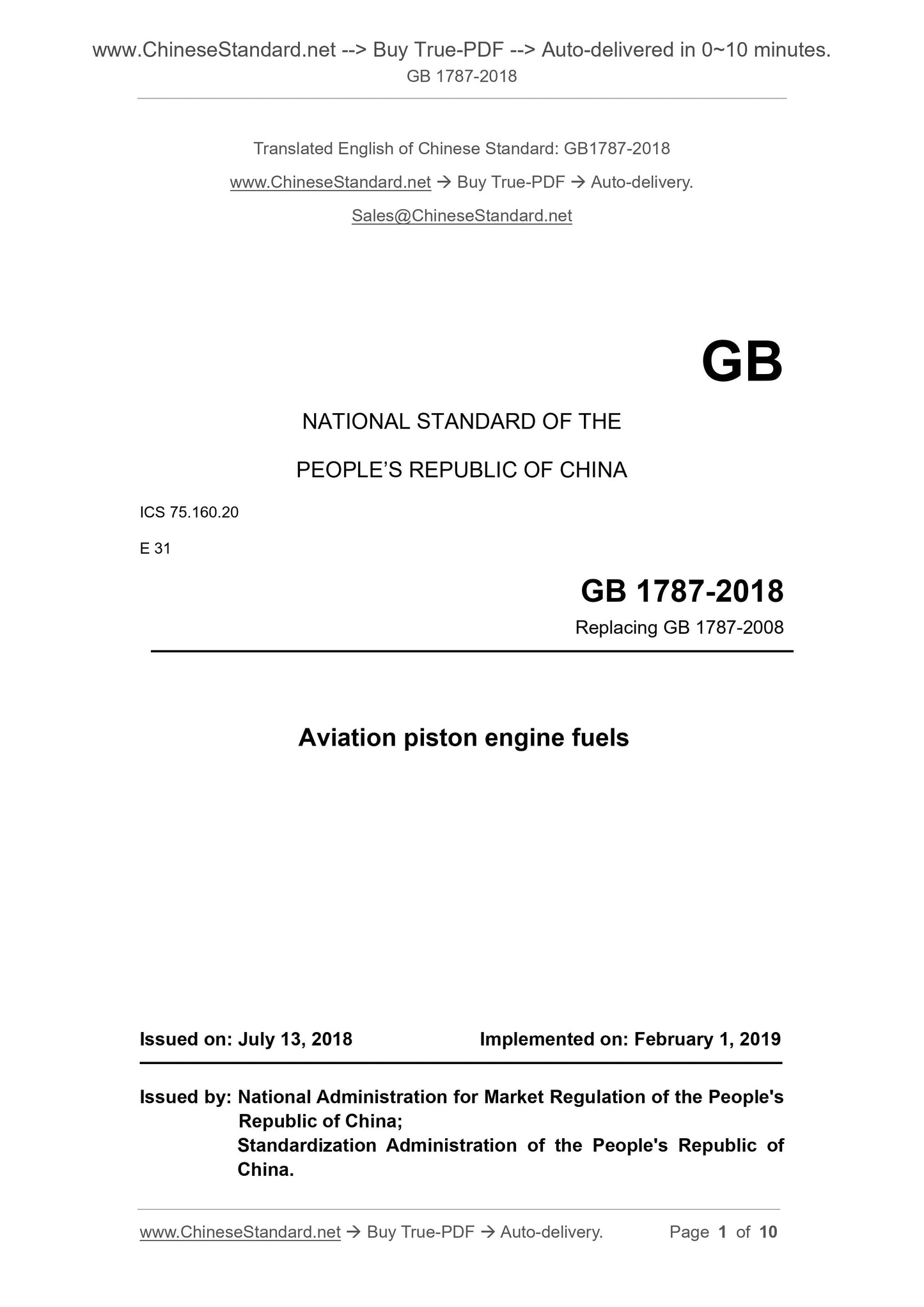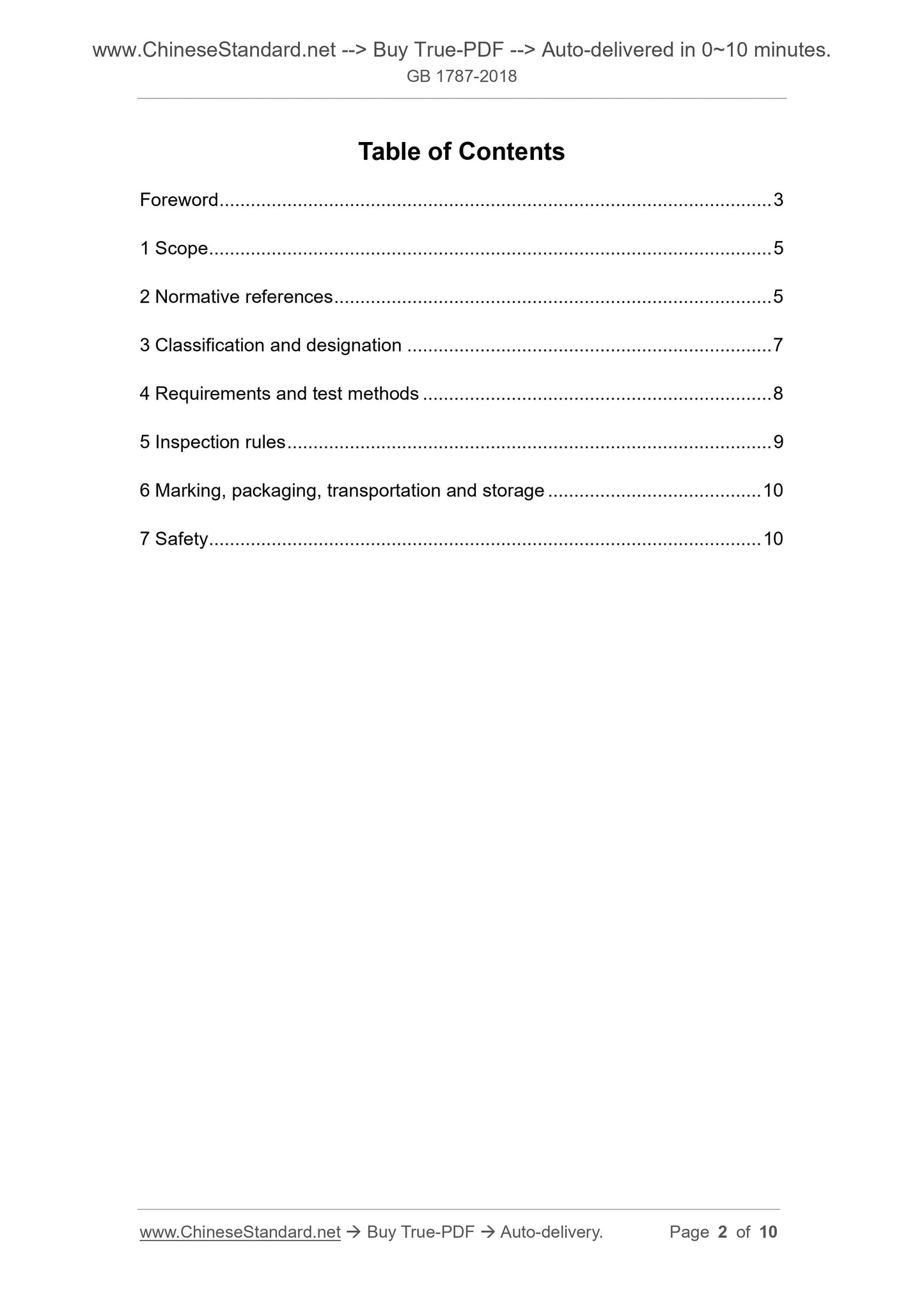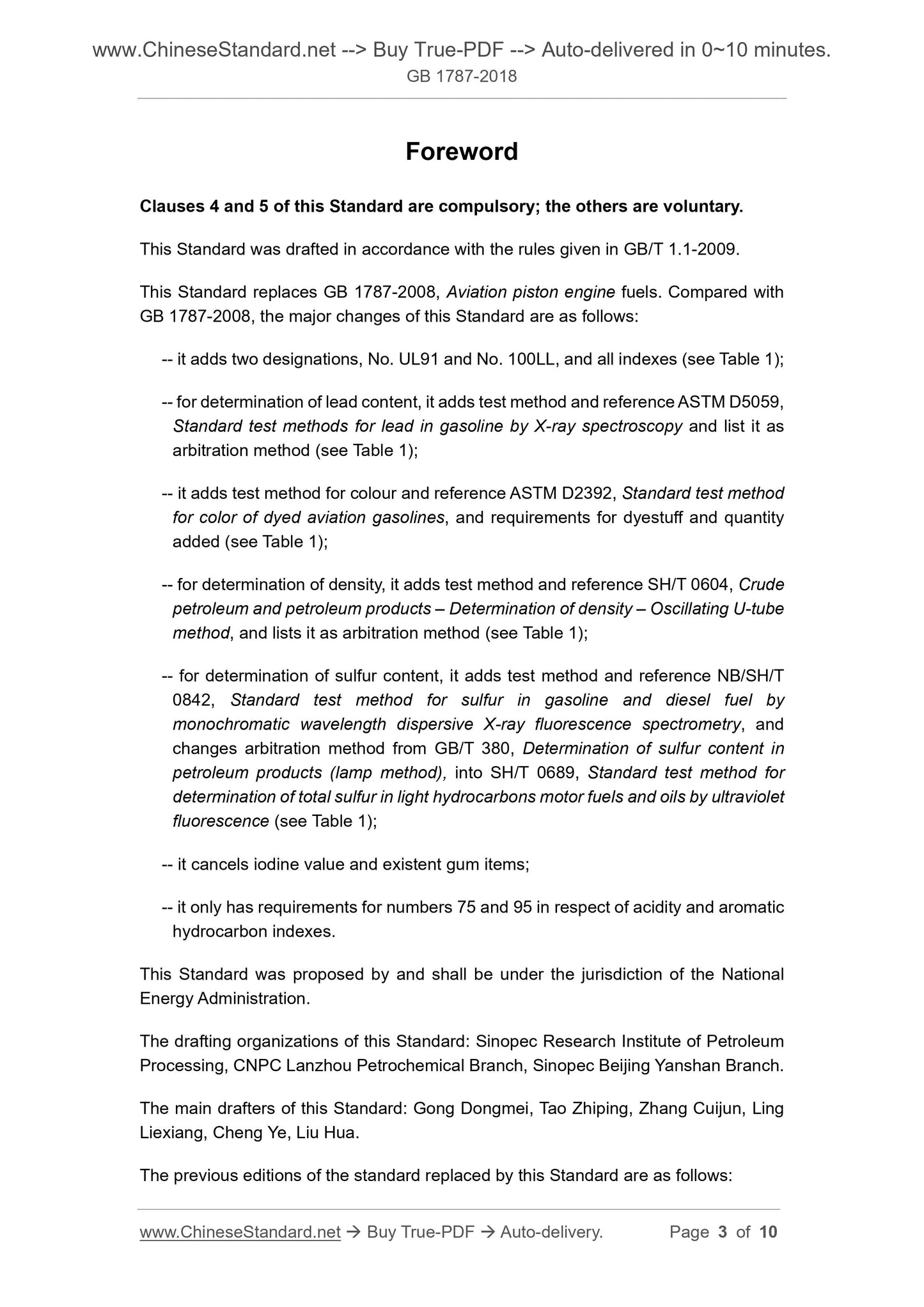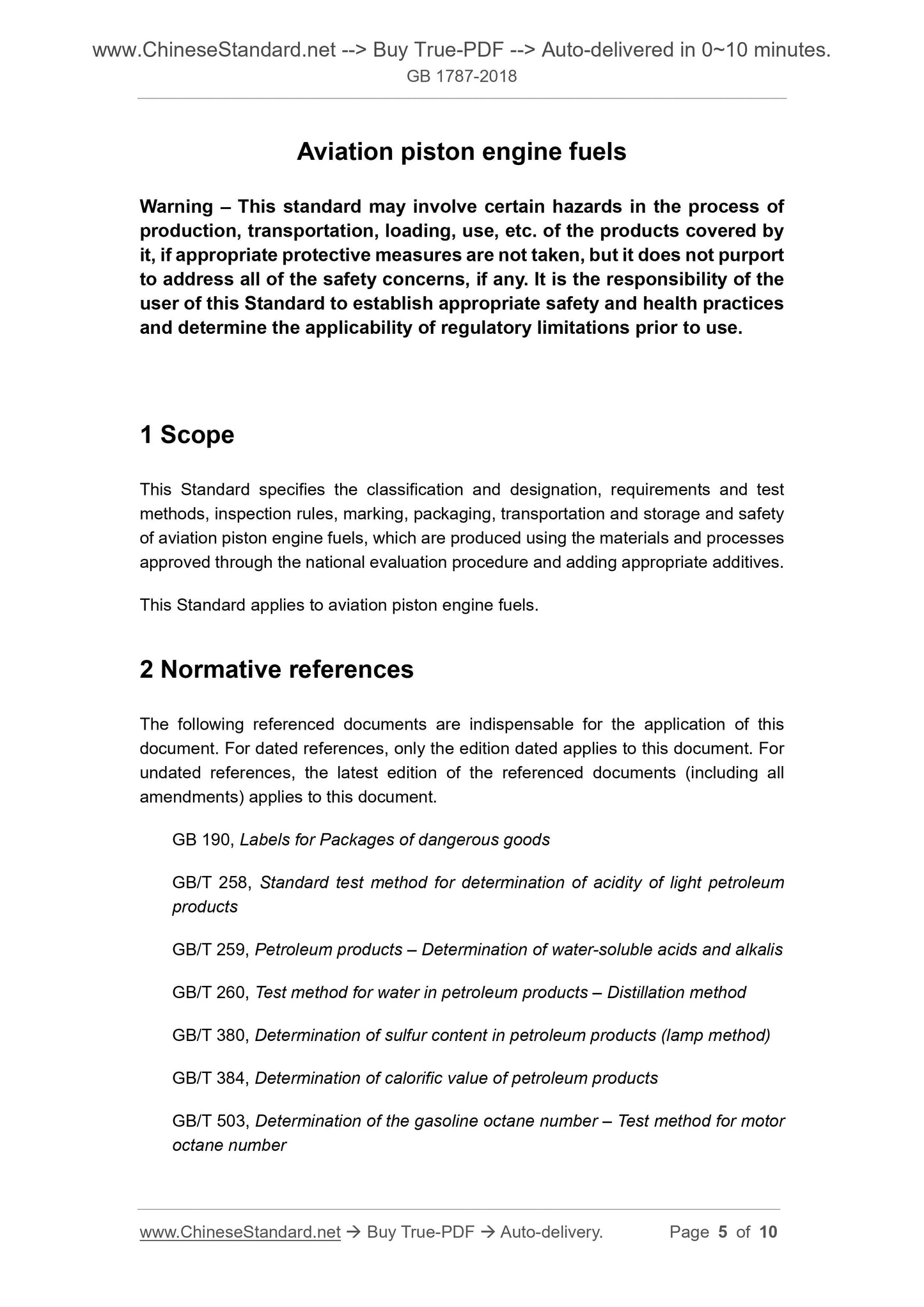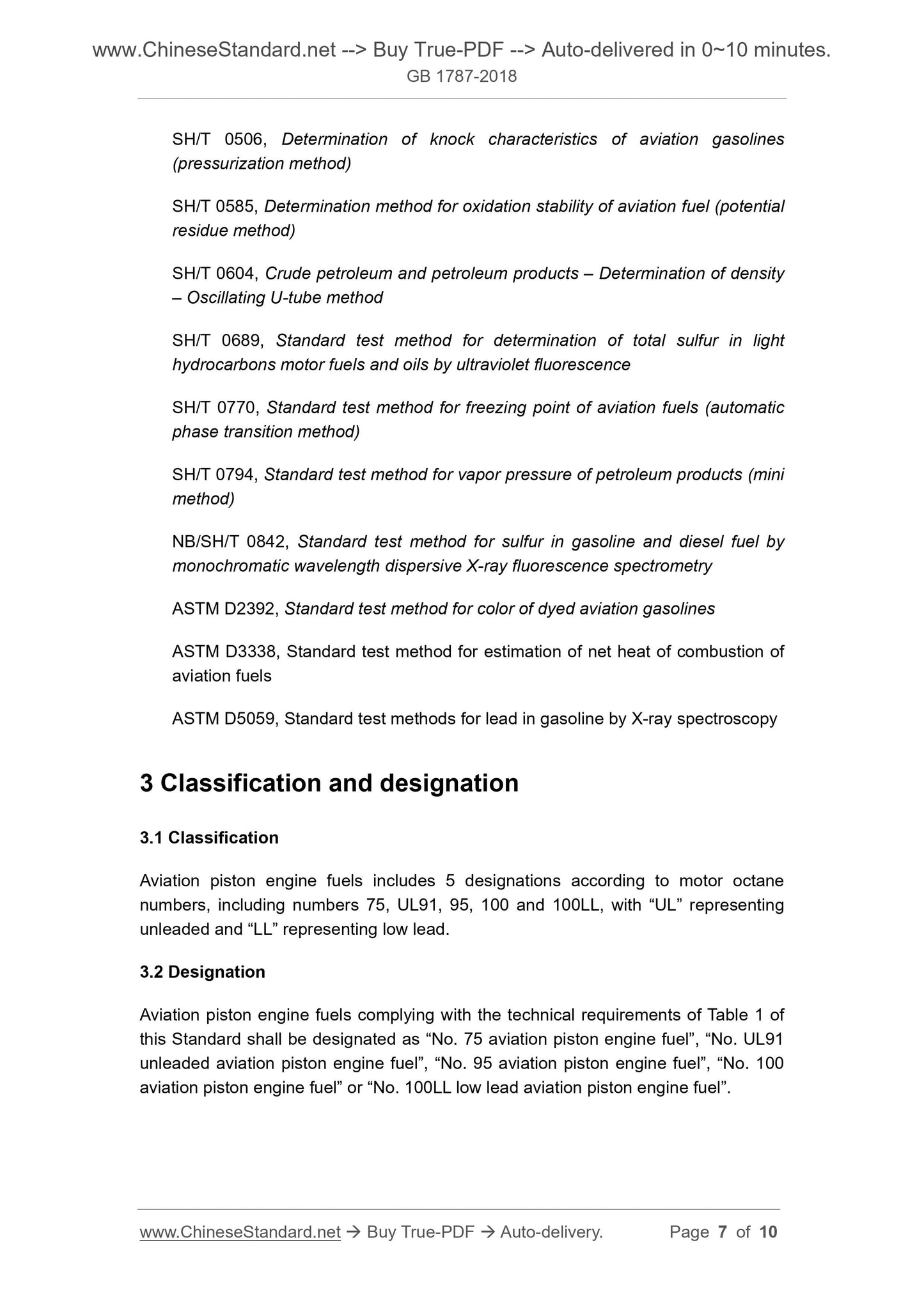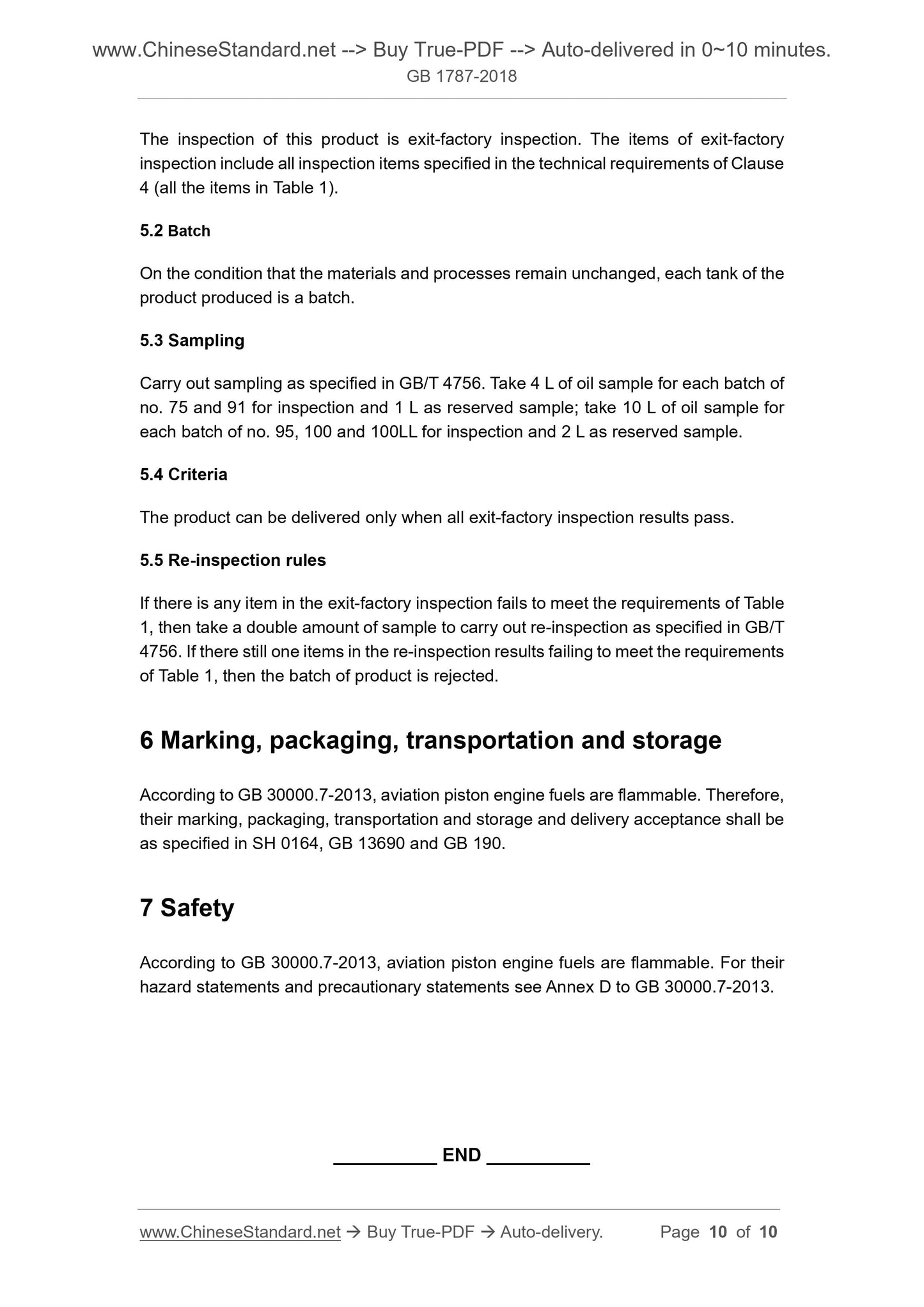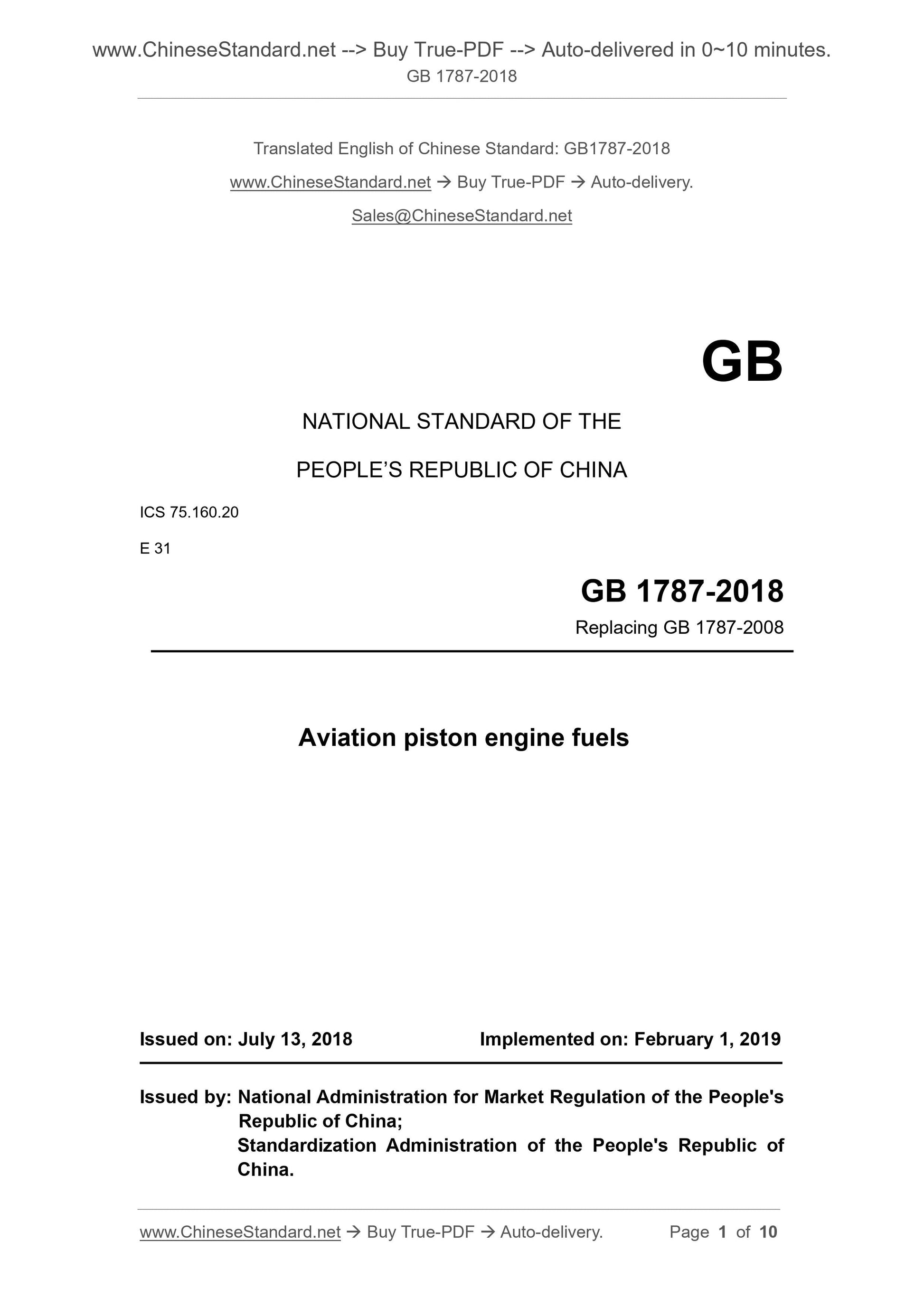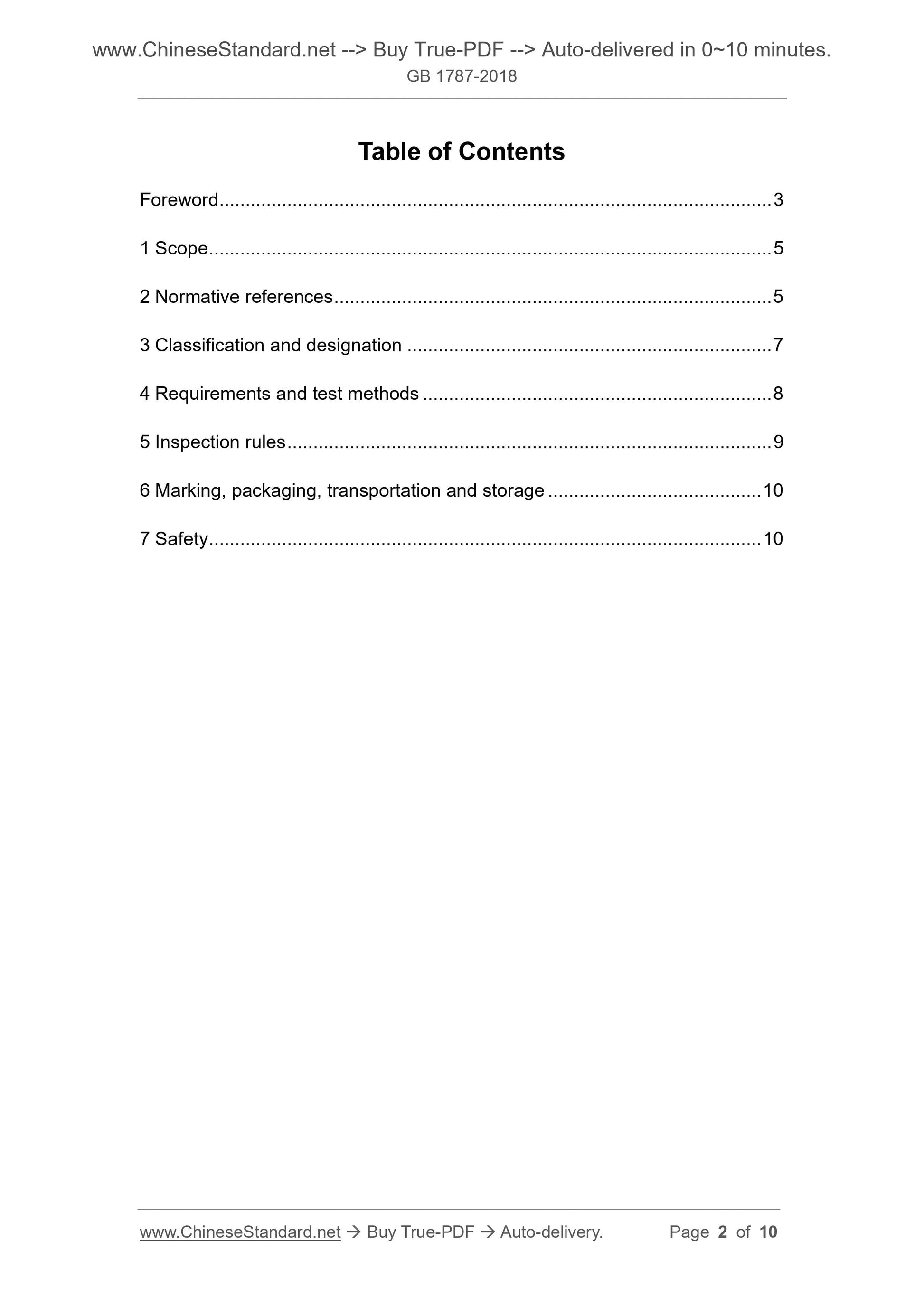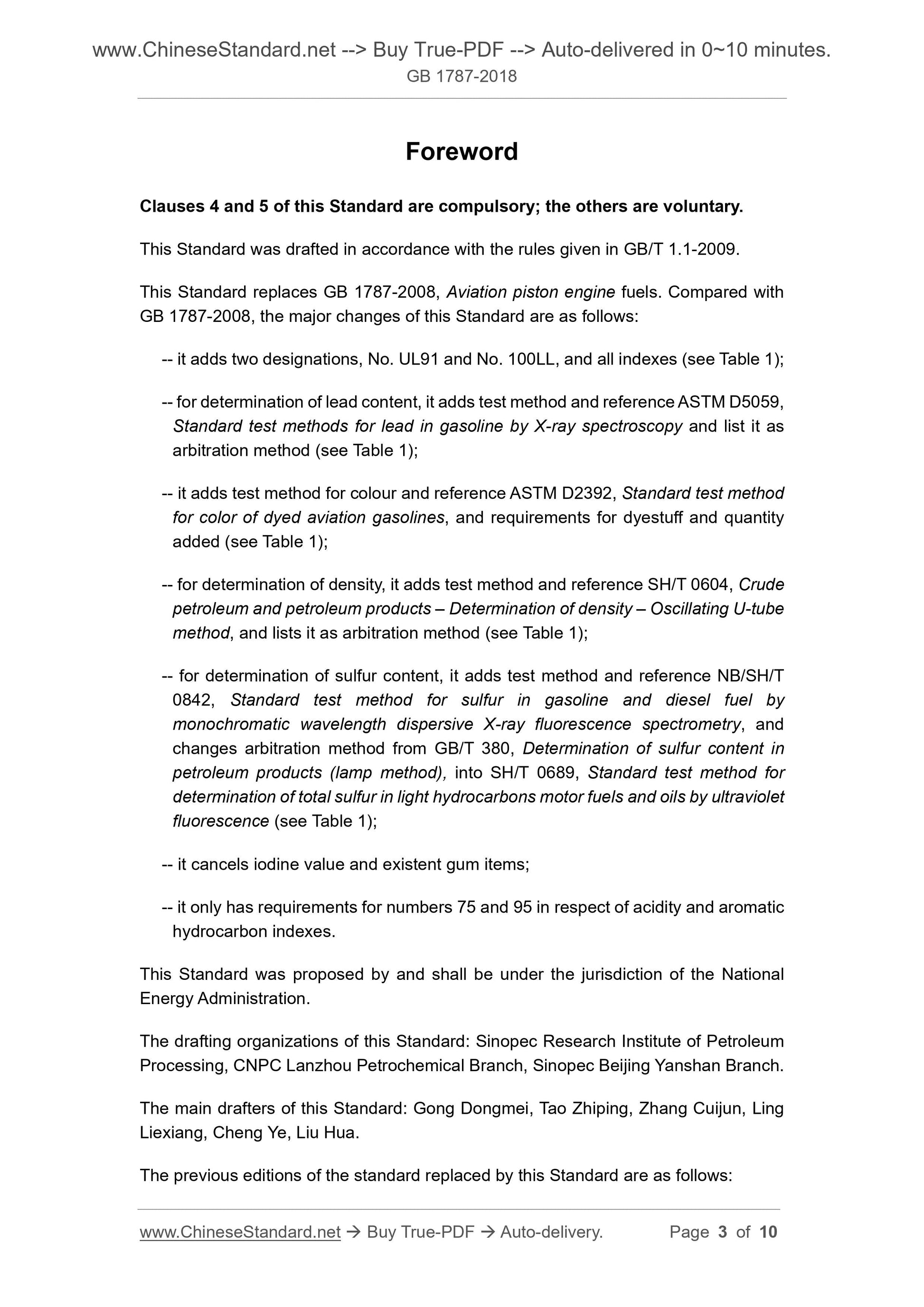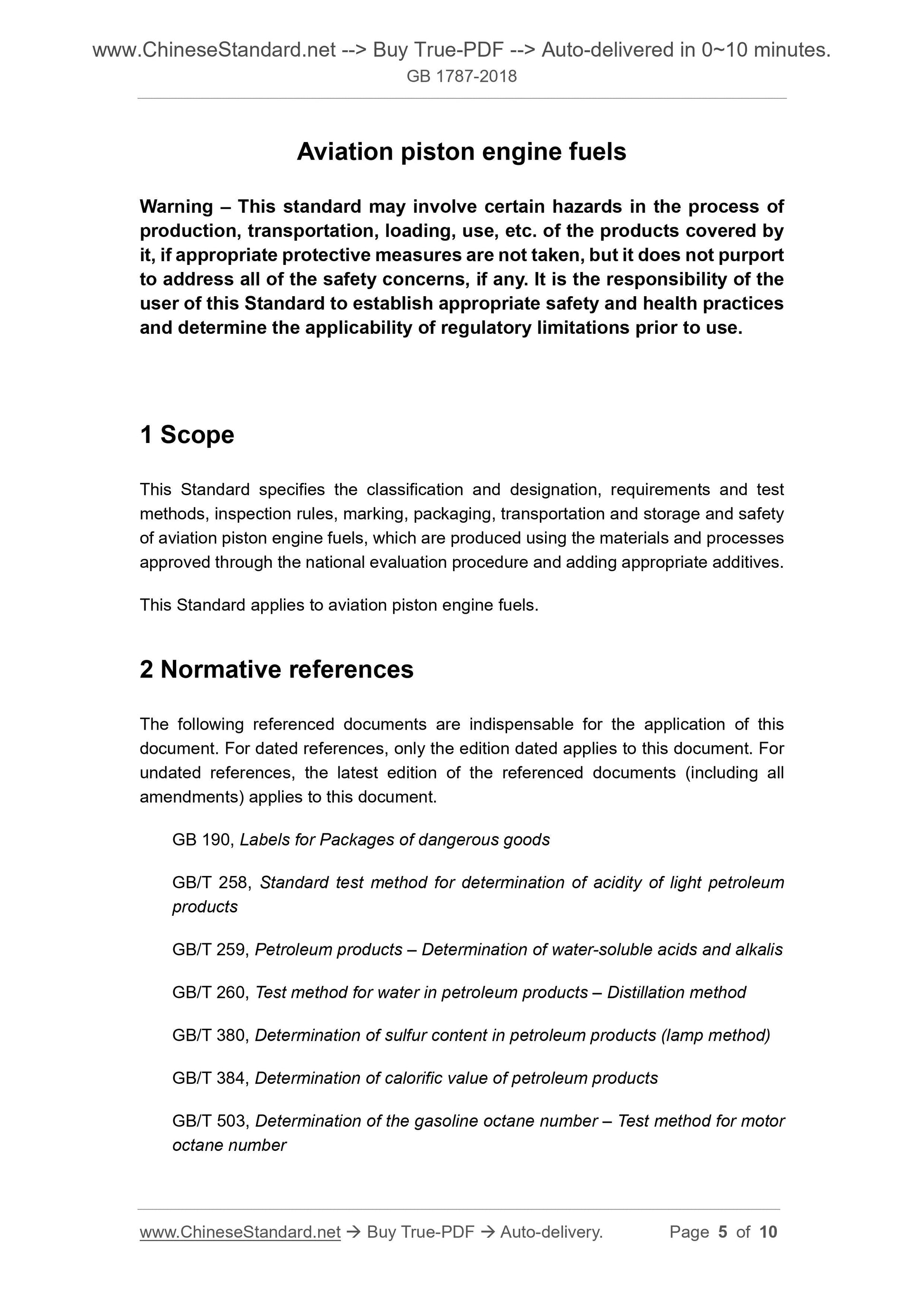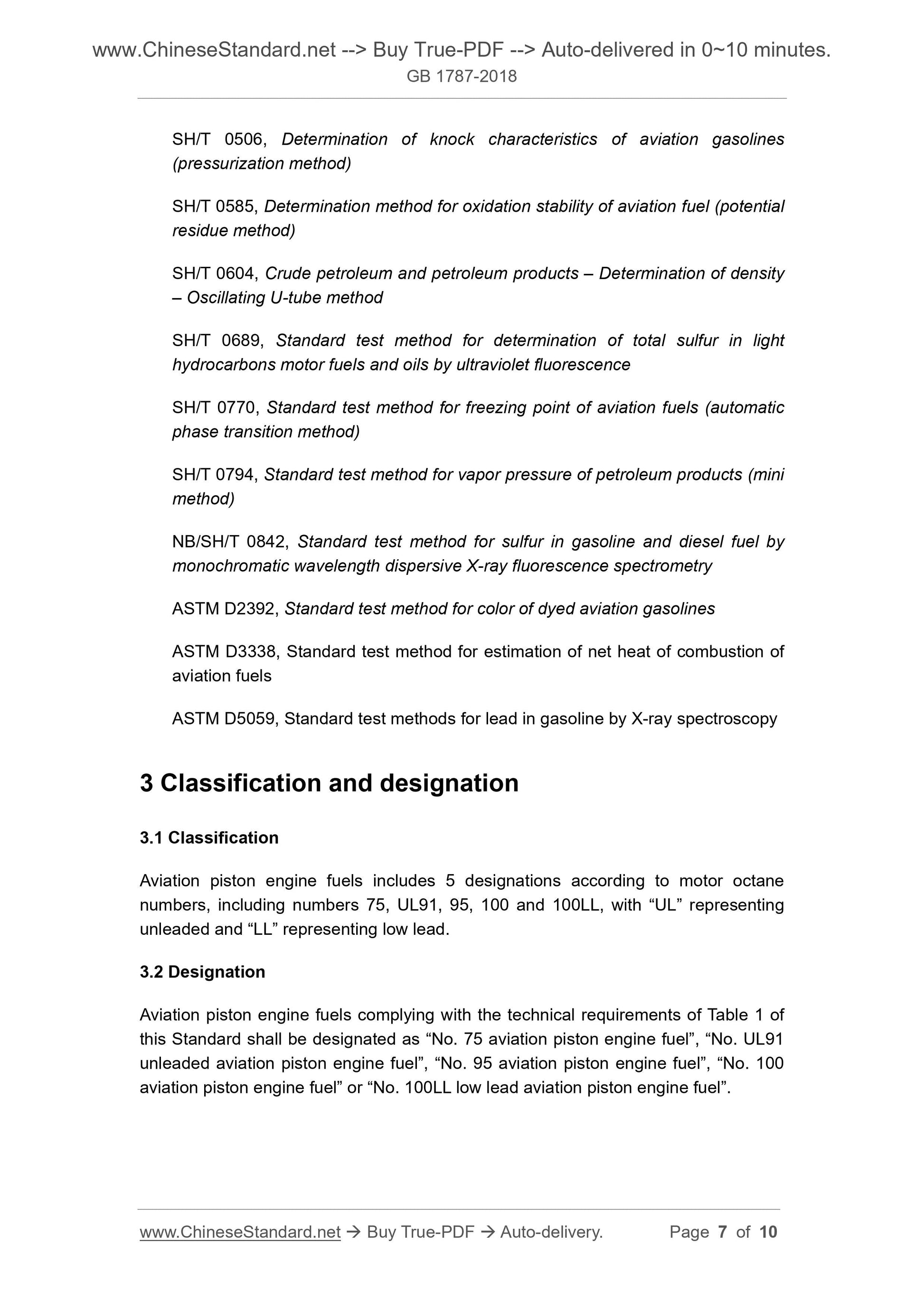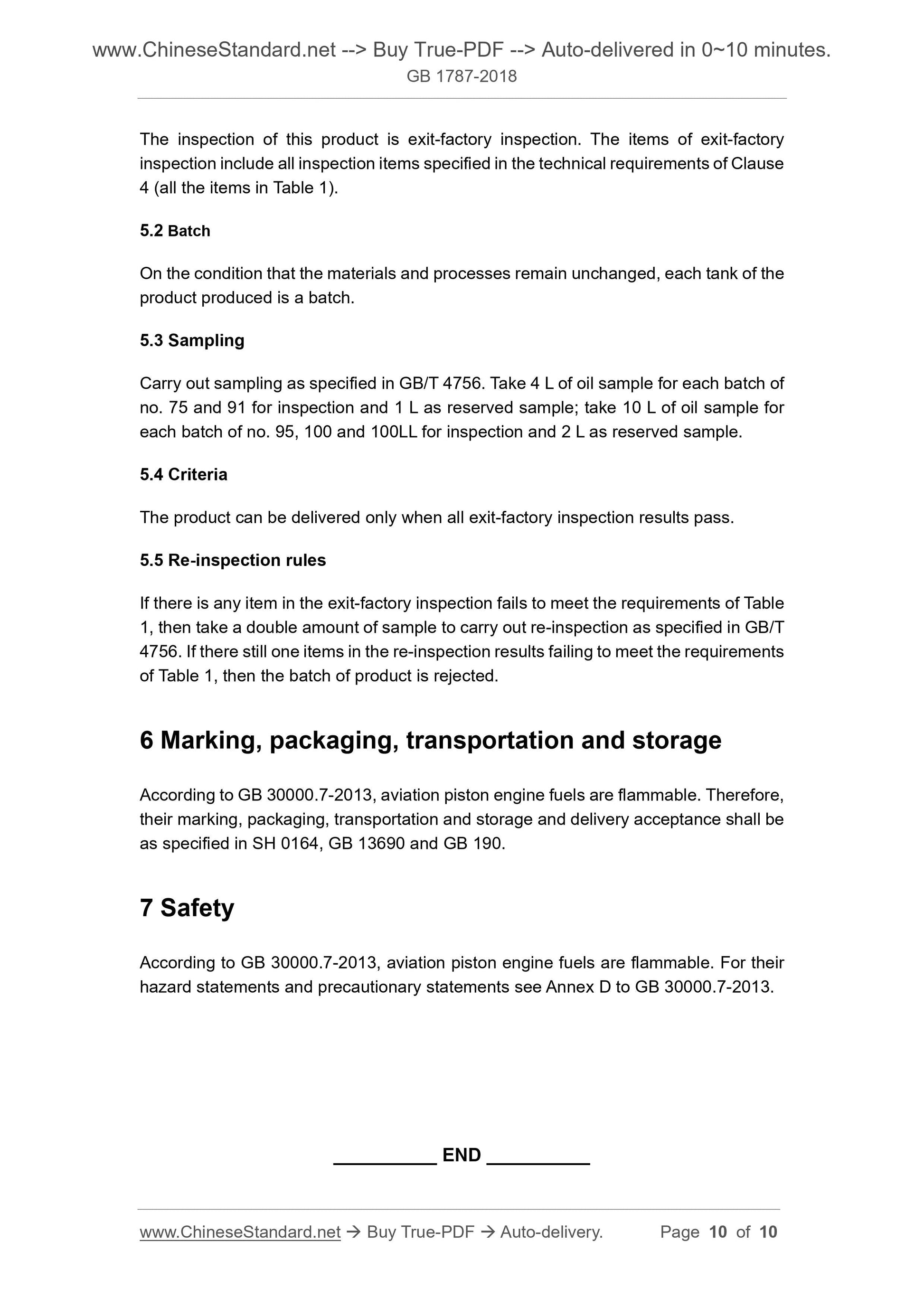1
/
of
6
www.ChineseStandard.us -- Field Test Asia Pte. Ltd.
GB 1787-2018 English PDF
GB 1787-2018 English PDF
Regular price
$140.00
Regular price
Sale price
$140.00
Unit price
/
per
Shipping calculated at checkout.
Couldn't load pickup availability
GB 1787-2018: Aviation piston engine fuels
Delivery: 9 seconds. Download (& Email) true-PDF + Invoice.
Get Quotation: Click GB 1787-2018 (Self-service in 1-minute)
Historical versions (Master-website): GB 1787-2018
Preview True-PDF (Reload/Scroll-down if blank)
GB 1787-2018
GB
NATIONAL STANDARD OF THE
PEOPLE’S REPUBLIC OF CHINA
ICS 75.160.20
E 31
Replacing GB 1787-2008
Aviation piston engine fuels
ISSUED ON. JULY 13, 2018
IMPLEMENTED ON. FEBRUARY 1, 2019
Issued by. National Administration for Market Regulation of the People's
Republic of China;
Standardization Administration of the People's Republic of
China.
Table of Contents
Foreword ... 3
1 Scope ... 5
2 Normative references ... 5
3 Classification and designation ... 7
4 Requirements and test methods ... 8
5 Inspection rules ... 9
6 Marking, packaging, transportation and storage ... 10
7 Safety ... 10
Foreword
Clauses 4 and 5 of this Standard are compulsory; the others are voluntary.
This Standard was drafted in accordance with the rules given in GB/T 1.1-2009.
This Standard replaces GB 1787-2008, Aviation piston engine fuels. Compared with
GB 1787-2008, the major changes of this Standard are as follows.
-- it adds two designations, No. UL91 and No. 100LL, and all indexes (see Table 1);
-- for determination of lead content, it adds test method and reference ASTM D5059,
Standard test methods for lead in gasoline by X-ray spectroscopy and list it as
arbitration method (see Table 1);
-- it adds test method for colour and reference ASTM D2392, Standard test method
for color of dyed aviation gasolines, and requirements for dyestuff and quantity
added (see Table 1);
-- for determination of density, it adds test method and reference SH/T 0604, Crude
petroleum and petroleum products – Determination of density – Oscillating U-tube
method, and lists it as arbitration method (see Table 1);
-- for determination of sulfur content, it adds test method and reference NB/SH/T
0842, Standard test method for sulfur in gasoline and diesel fuel by
monochromatic wavelength dispersive X-ray fluorescence spectrometry, and
changes arbitration method from GB/T 380, Determination of sulfur content in
petroleum products (lamp method), into SH/T 0689, Standard test method for
determination of total sulfur in light hydrocarbons motor fuels and oils by ultraviolet
fluorescence (see Table 1);
-- it cancels iodine value and existent gum items;
-- it only has requirements for numbers 75 and 95 in respect of acidity and aromatic
hydrocarbon indexes.
This Standard was proposed by and shall be under the jurisdiction of the National
Energy Administration.
The drafting organizations of this Standard. Sinopec Research Institute of Petroleum
Processing, CNPC Lanzhou Petrochemical Branch, Sinopec Beijing Yanshan Branch.
The main drafters of this Standard. Gong Dongmei, Tao Zhiping, Zhang Cuijun, Ling
Liexiang, Cheng Ye, Liu Hua.
The previous editions of the standard replaced by this Standard are as follows.
Aviation piston engine fuels
Warning – This standard may involve certain hazards in the process of
production, transportation, loading, use, etc. of the products covered by
it, if appropriate protective measures are not taken, but it does not purport
to address all of the safety concerns, if any. It is the responsibility of the
user of this Standard to establish appropriate safety and health practices
and determine the applicability of regulatory limitations prior to use.
1 Scope
This Standard specifies the classification and designation, requirements and test
methods, inspection rules, marking, packaging, transportation and storage and safety
of aviation piston engine fuels, which are produced using the materials and processes
approved through the national evaluation procedure and adding appropriate additives.
This Standard applies to aviation piston engine fuels.
2 Normative references
The following referenced documents are indispensable for the application of this
document. For dated references, only the edition dated applies to this document. For
undated references, the latest edition of the referenced documents (including all
amendments) applies to this document.
GB 190, Labels for Packages of dangerous goods
GB/T 258, Standard test method for determination of acidity of light petroleum
products
GB/T 259, Petroleum products – Determination of water-soluble acids and alkalis
GB/T 260, Test method for water in petroleum products – Distillation method
GB/T 380, Determination of sulfur content in petroleum products (lamp method)
GB/T 384, Determination of calorific value of petroleum products
GB/T 503, Determination of the gasoline octane number – Test method for motor
octane number
SH/T 0506, Determination of knock characteristics of aviation gasolines
(pressurization method)
SH/T 0585, Determination method for oxidation stability of aviation fuel (potential
residue method)
SH/T 0604, Crude petroleum and petroleum products – Determination of density
– Oscillating U-tube method
SH/T 0689, Standard test method for determination of total sulfur in light
hydrocarbons motor fuels and oils by ultraviolet fluorescence
SH/T 0770, Standard test method for freezing point of aviation fuels (automatic
phase transition method)
SH/T 0794, Standard test method for vapor pressure of petroleum products (mini
method)
NB/SH/T 0842, Standard test method for sulfur in gasoline and diesel fuel by
monochromatic wavelength dispersive X-ray fluorescence spectrometry
ASTM D2392, Standard test method for color of dyed aviation gasolines
ASTM D3338, Standard test method for estimation of net heat of combustion of
aviation fuels
ASTM D5059, Standard test methods for lead in gasoline by X-ray spectroscopy
3 Classification and designation
3.1 Classification
Aviation piston engine fuels includes 5 designations according to motor octane
numbers, including numbers 75, UL91, 95, 100 and 100LL, with “UL” representing
unleaded and “LL” representing low lead.
3.2 Designation
Aviation piston engine fuels complying with the technical requirements of Table 1 of
this Standard shall be designated as “No. 75 aviation piston engine fuel”, “No. UL91
unleaded aviation piston engine fuel”, “No. 95 aviation piston engine fuel”, “No. 100
aviation piston engine fuel” or “No. 100LL low lead aviation piston engine fuel”.
The inspection of this product is exit-factory inspection. The items of exit-factory
inspection include all inspection items specified in the technical requirements of Clause
4 (all the items in Table 1).
5.2 Batch
On the condition that the materials and processes remain unchanged, each tank of the
product produced is a batch.
5.3 Sampling
Carry out sampling as specified in GB/T 4756. Take 4 L of oil sample for each batch of
no. 75 and 91 for inspection and 1 L as reserved sample; take 10 L of oil sample for
each batch of no. 95, 100 and 100LL for inspection and 2 L as reserved sample.
5.4 Criteria
The product can be delivered only when all exit-factory inspection results pass.
5.5 Re-inspection rules
If there is any item in the exit-factory inspection fails to meet the requirements of Table
1, then take a double amount of sample to carry out re-inspection as specified in GB/T
4756. If there still one items in the re-inspection results failing to meet the requirements
of Table 1, then the batch of product is rejected.
6 Marking, packaging, transportation and storage
According to GB 30000.7-2013, aviation piston engine fuels are flammable. Therefore,
their marking, packaging, transportation and storage and delivery acceptance shall be
as specified in SH 0164, GB 13690 and GB 190.
7 Safety
According to GB 30000.7-2013, aviation piston engine fuels are flammable. For their
hazard statements and precautionary statements see Annex D to GB 30000.7-2013.
GB 1787-2018
GB
NATIONAL STANDARD OF THE
PEOPLE’S REPUBLIC OF CHINA
ICS 75.160.20
E 31
Replacing GB 1787-2008
Aviation piston engine fuels
ISSUED ON. JULY 13, 2018
IMPLEMENTED ON. FEBRUARY 1, 2019
Issued by. National Administration for Market Regulation of the People's
Republic of China;
Standardization Administration of the People's Republic of
China.
Table of Contents
Foreword ... 3
1 Scope ... 5
2 Normative references ... 5
3 Classification and designation ... 7
4 Requirements and test methods ... 8
5 Inspection rules ... 9
6 Marking, packaging, transportation and storage ... 10
7 Safety ... 10
Foreword
Clauses 4 and 5 of this Standard are compulsory; the others are voluntary.
This Standard was drafted in accordance with the rules given in GB/T 1.1-2009.
This Standard replaces GB 1787-2008, Aviation piston engine fuels. Compared with
GB 1787-2008, the major changes of this Standard are as follows.
-- it adds two designations, No. UL91 and No. 100LL, and all indexes (see Table 1);
-- for determination of lead content, it adds test method and reference ASTM D5059,
Standard test methods for lead in gasoline by X-ray spectroscopy and list it as
arbitration method (see Table 1);
-- it adds test method for colour and reference ASTM D2392, Standard test method
for color of dyed aviation gasolines, and requirements for dyestuff and quantity
added (see Table 1);
-- for determination of density, it adds test method and reference SH/T 0604, Crude
petroleum and petroleum products – Determination of density – Oscillating U-tube
method, and lists it as arbitration method (see Table 1);
-- for determination of sulfur content, it adds test method and reference NB/SH/T
0842, Standard test method for sulfur in gasoline and diesel fuel by
monochromatic wavelength dispersive X-ray fluorescence spectrometry, and
changes arbitration method from GB/T 380, Determination of sulfur content in
petroleum products (lamp method), into SH/T 0689, Standard test method for
determination of total sulfur in light hydrocarbons motor fuels and oils by ultraviolet
fluorescence (see Table 1);
-- it cancels iodine value and existent gum items;
-- it only has requirements for numbers 75 and 95 in respect of acidity and aromatic
hydrocarbon indexes.
This Standard was proposed by and shall be under the jurisdiction of the National
Energy Administration.
The drafting organizations of this Standard. Sinopec Research Institute of Petroleum
Processing, CNPC Lanzhou Petrochemical Branch, Sinopec Beijing Yanshan Branch.
The main drafters of this Standard. Gong Dongmei, Tao Zhiping, Zhang Cuijun, Ling
Liexiang, Cheng Ye, Liu Hua.
The previous editions of the standard replaced by this Standard are as follows.
Aviation piston engine fuels
Warning – This standard may involve certain hazards in the process of
production, transportation, loading, use, etc. of the products covered by
it, if appropriate protective measures are not taken, but it does not purport
to address all of the safety concerns, if any. It is the responsibility of the
user of this Standard to establish appropriate safety and health practices
and determine the applicability of regulatory limitations prior to use.
1 Scope
This Standard specifies the classification and designation, requirements and test
methods, inspection rules, marking, packaging, transportation and storage and safety
of aviation piston engine fuels, which are produced using the materials and processes
approved through the national evaluation procedure and adding appropriate additives.
This Standard applies to aviation piston engine fuels.
2 Normative references
The following referenced documents are indispensable for the application of this
document. For dated references, only the edition dated applies to this document. For
undated references, the latest edition of the referenced documents (including all
amendments) applies to this document.
GB 190, Labels for Packages of dangerous goods
GB/T 258, Standard test method for determination of acidity of light petroleum
products
GB/T 259, Petroleum products – Determination of water-soluble acids and alkalis
GB/T 260, Test method for water in petroleum products – Distillation method
GB/T 380, Determination of sulfur content in petroleum products (lamp method)
GB/T 384, Determination of calorific value of petroleum products
GB/T 503, Determination of the gasoline octane number – Test method for motor
octane number
SH/T 0506, Determination of knock characteristics of aviation gasolines
(pressurization method)
SH/T 0585, Determination method for oxidation stability of aviation fuel (potential
residue method)
SH/T 0604, Crude petroleum and petroleum products – Determination of density
– Oscillating U-tube method
SH/T 0689, Standard test method for determination of total sulfur in light
hydrocarbons motor fuels and oils by ultraviolet fluorescence
SH/T 0770, Standard test method for freezing point of aviation fuels (automatic
phase transition method)
SH/T 0794, Standard test method for vapor pressure of petroleum products (mini
method)
NB/SH/T 0842, Standard test method for sulfur in gasoline and diesel fuel by
monochromatic wavelength dispersive X-ray fluorescence spectrometry
ASTM D2392, Standard test method for color of dyed aviation gasolines
ASTM D3338, Standard test method for estimation of net heat of combustion of
aviation fuels
ASTM D5059, Standard test methods for lead in gasoline by X-ray spectroscopy
3 Classification and designation
3.1 Classification
Aviation piston engine fuels includes 5 designations according to motor octane
numbers, including numbers 75, UL91, 95, 100 and 100LL, with “UL” representing
unleaded and “LL” representing low lead.
3.2 Designation
Aviation piston engine fuels complying with the technical requirements of Table 1 of
this Standard shall be designated as “No. 75 aviation piston engine fuel”, “No. UL91
unleaded aviation piston engine fuel”, “No. 95 aviation piston engine fuel”, “No. 100
aviation piston engine fuel” or “No. 100LL low lead aviation piston engine fuel”.
The inspection of this product is exit-factory inspection. The items of exit-factory
inspection include all inspection items specified in the technical requirements of Clause
4 (all the items in Table 1).
5....
Delivery: 9 seconds. Download (& Email) true-PDF + Invoice.
Get Quotation: Click GB 1787-2018 (Self-service in 1-minute)
Historical versions (Master-website): GB 1787-2018
Preview True-PDF (Reload/Scroll-down if blank)
GB 1787-2018
GB
NATIONAL STANDARD OF THE
PEOPLE’S REPUBLIC OF CHINA
ICS 75.160.20
E 31
Replacing GB 1787-2008
Aviation piston engine fuels
ISSUED ON. JULY 13, 2018
IMPLEMENTED ON. FEBRUARY 1, 2019
Issued by. National Administration for Market Regulation of the People's
Republic of China;
Standardization Administration of the People's Republic of
China.
Table of Contents
Foreword ... 3
1 Scope ... 5
2 Normative references ... 5
3 Classification and designation ... 7
4 Requirements and test methods ... 8
5 Inspection rules ... 9
6 Marking, packaging, transportation and storage ... 10
7 Safety ... 10
Foreword
Clauses 4 and 5 of this Standard are compulsory; the others are voluntary.
This Standard was drafted in accordance with the rules given in GB/T 1.1-2009.
This Standard replaces GB 1787-2008, Aviation piston engine fuels. Compared with
GB 1787-2008, the major changes of this Standard are as follows.
-- it adds two designations, No. UL91 and No. 100LL, and all indexes (see Table 1);
-- for determination of lead content, it adds test method and reference ASTM D5059,
Standard test methods for lead in gasoline by X-ray spectroscopy and list it as
arbitration method (see Table 1);
-- it adds test method for colour and reference ASTM D2392, Standard test method
for color of dyed aviation gasolines, and requirements for dyestuff and quantity
added (see Table 1);
-- for determination of density, it adds test method and reference SH/T 0604, Crude
petroleum and petroleum products – Determination of density – Oscillating U-tube
method, and lists it as arbitration method (see Table 1);
-- for determination of sulfur content, it adds test method and reference NB/SH/T
0842, Standard test method for sulfur in gasoline and diesel fuel by
monochromatic wavelength dispersive X-ray fluorescence spectrometry, and
changes arbitration method from GB/T 380, Determination of sulfur content in
petroleum products (lamp method), into SH/T 0689, Standard test method for
determination of total sulfur in light hydrocarbons motor fuels and oils by ultraviolet
fluorescence (see Table 1);
-- it cancels iodine value and existent gum items;
-- it only has requirements for numbers 75 and 95 in respect of acidity and aromatic
hydrocarbon indexes.
This Standard was proposed by and shall be under the jurisdiction of the National
Energy Administration.
The drafting organizations of this Standard. Sinopec Research Institute of Petroleum
Processing, CNPC Lanzhou Petrochemical Branch, Sinopec Beijing Yanshan Branch.
The main drafters of this Standard. Gong Dongmei, Tao Zhiping, Zhang Cuijun, Ling
Liexiang, Cheng Ye, Liu Hua.
The previous editions of the standard replaced by this Standard are as follows.
Aviation piston engine fuels
Warning – This standard may involve certain hazards in the process of
production, transportation, loading, use, etc. of the products covered by
it, if appropriate protective measures are not taken, but it does not purport
to address all of the safety concerns, if any. It is the responsibility of the
user of this Standard to establish appropriate safety and health practices
and determine the applicability of regulatory limitations prior to use.
1 Scope
This Standard specifies the classification and designation, requirements and test
methods, inspection rules, marking, packaging, transportation and storage and safety
of aviation piston engine fuels, which are produced using the materials and processes
approved through the national evaluation procedure and adding appropriate additives.
This Standard applies to aviation piston engine fuels.
2 Normative references
The following referenced documents are indispensable for the application of this
document. For dated references, only the edition dated applies to this document. For
undated references, the latest edition of the referenced documents (including all
amendments) applies to this document.
GB 190, Labels for Packages of dangerous goods
GB/T 258, Standard test method for determination of acidity of light petroleum
products
GB/T 259, Petroleum products – Determination of water-soluble acids and alkalis
GB/T 260, Test method for water in petroleum products – Distillation method
GB/T 380, Determination of sulfur content in petroleum products (lamp method)
GB/T 384, Determination of calorific value of petroleum products
GB/T 503, Determination of the gasoline octane number – Test method for motor
octane number
SH/T 0506, Determination of knock characteristics of aviation gasolines
(pressurization method)
SH/T 0585, Determination method for oxidation stability of aviation fuel (potential
residue method)
SH/T 0604, Crude petroleum and petroleum products – Determination of density
– Oscillating U-tube method
SH/T 0689, Standard test method for determination of total sulfur in light
hydrocarbons motor fuels and oils by ultraviolet fluorescence
SH/T 0770, Standard test method for freezing point of aviation fuels (automatic
phase transition method)
SH/T 0794, Standard test method for vapor pressure of petroleum products (mini
method)
NB/SH/T 0842, Standard test method for sulfur in gasoline and diesel fuel by
monochromatic wavelength dispersive X-ray fluorescence spectrometry
ASTM D2392, Standard test method for color of dyed aviation gasolines
ASTM D3338, Standard test method for estimation of net heat of combustion of
aviation fuels
ASTM D5059, Standard test methods for lead in gasoline by X-ray spectroscopy
3 Classification and designation
3.1 Classification
Aviation piston engine fuels includes 5 designations according to motor octane
numbers, including numbers 75, UL91, 95, 100 and 100LL, with “UL” representing
unleaded and “LL” representing low lead.
3.2 Designation
Aviation piston engine fuels complying with the technical requirements of Table 1 of
this Standard shall be designated as “No. 75 aviation piston engine fuel”, “No. UL91
unleaded aviation piston engine fuel”, “No. 95 aviation piston engine fuel”, “No. 100
aviation piston engine fuel” or “No. 100LL low lead aviation piston engine fuel”.
The inspection of this product is exit-factory inspection. The items of exit-factory
inspection include all inspection items specified in the technical requirements of Clause
4 (all the items in Table 1).
5.2 Batch
On the condition that the materials and processes remain unchanged, each tank of the
product produced is a batch.
5.3 Sampling
Carry out sampling as specified in GB/T 4756. Take 4 L of oil sample for each batch of
no. 75 and 91 for inspection and 1 L as reserved sample; take 10 L of oil sample for
each batch of no. 95, 100 and 100LL for inspection and 2 L as reserved sample.
5.4 Criteria
The product can be delivered only when all exit-factory inspection results pass.
5.5 Re-inspection rules
If there is any item in the exit-factory inspection fails to meet the requirements of Table
1, then take a double amount of sample to carry out re-inspection as specified in GB/T
4756. If there still one items in the re-inspection results failing to meet the requirements
of Table 1, then the batch of product is rejected.
6 Marking, packaging, transportation and storage
According to GB 30000.7-2013, aviation piston engine fuels are flammable. Therefore,
their marking, packaging, transportation and storage and delivery acceptance shall be
as specified in SH 0164, GB 13690 and GB 190.
7 Safety
According to GB 30000.7-2013, aviation piston engine fuels are flammable. For their
hazard statements and precautionary statements see Annex D to GB 30000.7-2013.
GB 1787-2018
GB
NATIONAL STANDARD OF THE
PEOPLE’S REPUBLIC OF CHINA
ICS 75.160.20
E 31
Replacing GB 1787-2008
Aviation piston engine fuels
ISSUED ON. JULY 13, 2018
IMPLEMENTED ON. FEBRUARY 1, 2019
Issued by. National Administration for Market Regulation of the People's
Republic of China;
Standardization Administration of the People's Republic of
China.
Table of Contents
Foreword ... 3
1 Scope ... 5
2 Normative references ... 5
3 Classification and designation ... 7
4 Requirements and test methods ... 8
5 Inspection rules ... 9
6 Marking, packaging, transportation and storage ... 10
7 Safety ... 10
Foreword
Clauses 4 and 5 of this Standard are compulsory; the others are voluntary.
This Standard was drafted in accordance with the rules given in GB/T 1.1-2009.
This Standard replaces GB 1787-2008, Aviation piston engine fuels. Compared with
GB 1787-2008, the major changes of this Standard are as follows.
-- it adds two designations, No. UL91 and No. 100LL, and all indexes (see Table 1);
-- for determination of lead content, it adds test method and reference ASTM D5059,
Standard test methods for lead in gasoline by X-ray spectroscopy and list it as
arbitration method (see Table 1);
-- it adds test method for colour and reference ASTM D2392, Standard test method
for color of dyed aviation gasolines, and requirements for dyestuff and quantity
added (see Table 1);
-- for determination of density, it adds test method and reference SH/T 0604, Crude
petroleum and petroleum products – Determination of density – Oscillating U-tube
method, and lists it as arbitration method (see Table 1);
-- for determination of sulfur content, it adds test method and reference NB/SH/T
0842, Standard test method for sulfur in gasoline and diesel fuel by
monochromatic wavelength dispersive X-ray fluorescence spectrometry, and
changes arbitration method from GB/T 380, Determination of sulfur content in
petroleum products (lamp method), into SH/T 0689, Standard test method for
determination of total sulfur in light hydrocarbons motor fuels and oils by ultraviolet
fluorescence (see Table 1);
-- it cancels iodine value and existent gum items;
-- it only has requirements for numbers 75 and 95 in respect of acidity and aromatic
hydrocarbon indexes.
This Standard was proposed by and shall be under the jurisdiction of the National
Energy Administration.
The drafting organizations of this Standard. Sinopec Research Institute of Petroleum
Processing, CNPC Lanzhou Petrochemical Branch, Sinopec Beijing Yanshan Branch.
The main drafters of this Standard. Gong Dongmei, Tao Zhiping, Zhang Cuijun, Ling
Liexiang, Cheng Ye, Liu Hua.
The previous editions of the standard replaced by this Standard are as follows.
Aviation piston engine fuels
Warning – This standard may involve certain hazards in the process of
production, transportation, loading, use, etc. of the products covered by
it, if appropriate protective measures are not taken, but it does not purport
to address all of the safety concerns, if any. It is the responsibility of the
user of this Standard to establish appropriate safety and health practices
and determine the applicability of regulatory limitations prior to use.
1 Scope
This Standard specifies the classification and designation, requirements and test
methods, inspection rules, marking, packaging, transportation and storage and safety
of aviation piston engine fuels, which are produced using the materials and processes
approved through the national evaluation procedure and adding appropriate additives.
This Standard applies to aviation piston engine fuels.
2 Normative references
The following referenced documents are indispensable for the application of this
document. For dated references, only the edition dated applies to this document. For
undated references, the latest edition of the referenced documents (including all
amendments) applies to this document.
GB 190, Labels for Packages of dangerous goods
GB/T 258, Standard test method for determination of acidity of light petroleum
products
GB/T 259, Petroleum products – Determination of water-soluble acids and alkalis
GB/T 260, Test method for water in petroleum products – Distillation method
GB/T 380, Determination of sulfur content in petroleum products (lamp method)
GB/T 384, Determination of calorific value of petroleum products
GB/T 503, Determination of the gasoline octane number – Test method for motor
octane number
SH/T 0506, Determination of knock characteristics of aviation gasolines
(pressurization method)
SH/T 0585, Determination method for oxidation stability of aviation fuel (potential
residue method)
SH/T 0604, Crude petroleum and petroleum products – Determination of density
– Oscillating U-tube method
SH/T 0689, Standard test method for determination of total sulfur in light
hydrocarbons motor fuels and oils by ultraviolet fluorescence
SH/T 0770, Standard test method for freezing point of aviation fuels (automatic
phase transition method)
SH/T 0794, Standard test method for vapor pressure of petroleum products (mini
method)
NB/SH/T 0842, Standard test method for sulfur in gasoline and diesel fuel by
monochromatic wavelength dispersive X-ray fluorescence spectrometry
ASTM D2392, Standard test method for color of dyed aviation gasolines
ASTM D3338, Standard test method for estimation of net heat of combustion of
aviation fuels
ASTM D5059, Standard test methods for lead in gasoline by X-ray spectroscopy
3 Classification and designation
3.1 Classification
Aviation piston engine fuels includes 5 designations according to motor octane
numbers, including numbers 75, UL91, 95, 100 and 100LL, with “UL” representing
unleaded and “LL” representing low lead.
3.2 Designation
Aviation piston engine fuels complying with the technical requirements of Table 1 of
this Standard shall be designated as “No. 75 aviation piston engine fuel”, “No. UL91
unleaded aviation piston engine fuel”, “No. 95 aviation piston engine fuel”, “No. 100
aviation piston engine fuel” or “No. 100LL low lead aviation piston engine fuel”.
The inspection of this product is exit-factory inspection. The items of exit-factory
inspection include all inspection items specified in the technical requirements of Clause
4 (all the items in Table 1).
5....
Share
